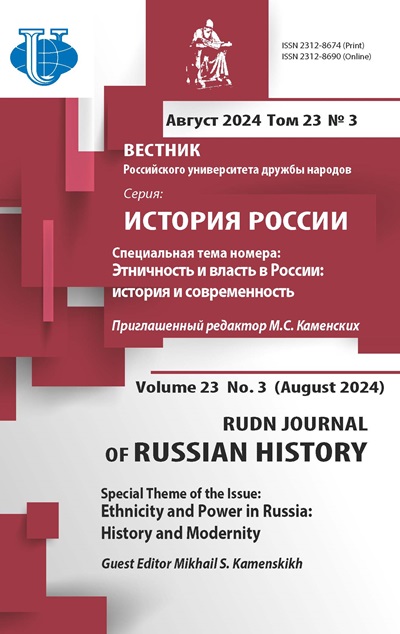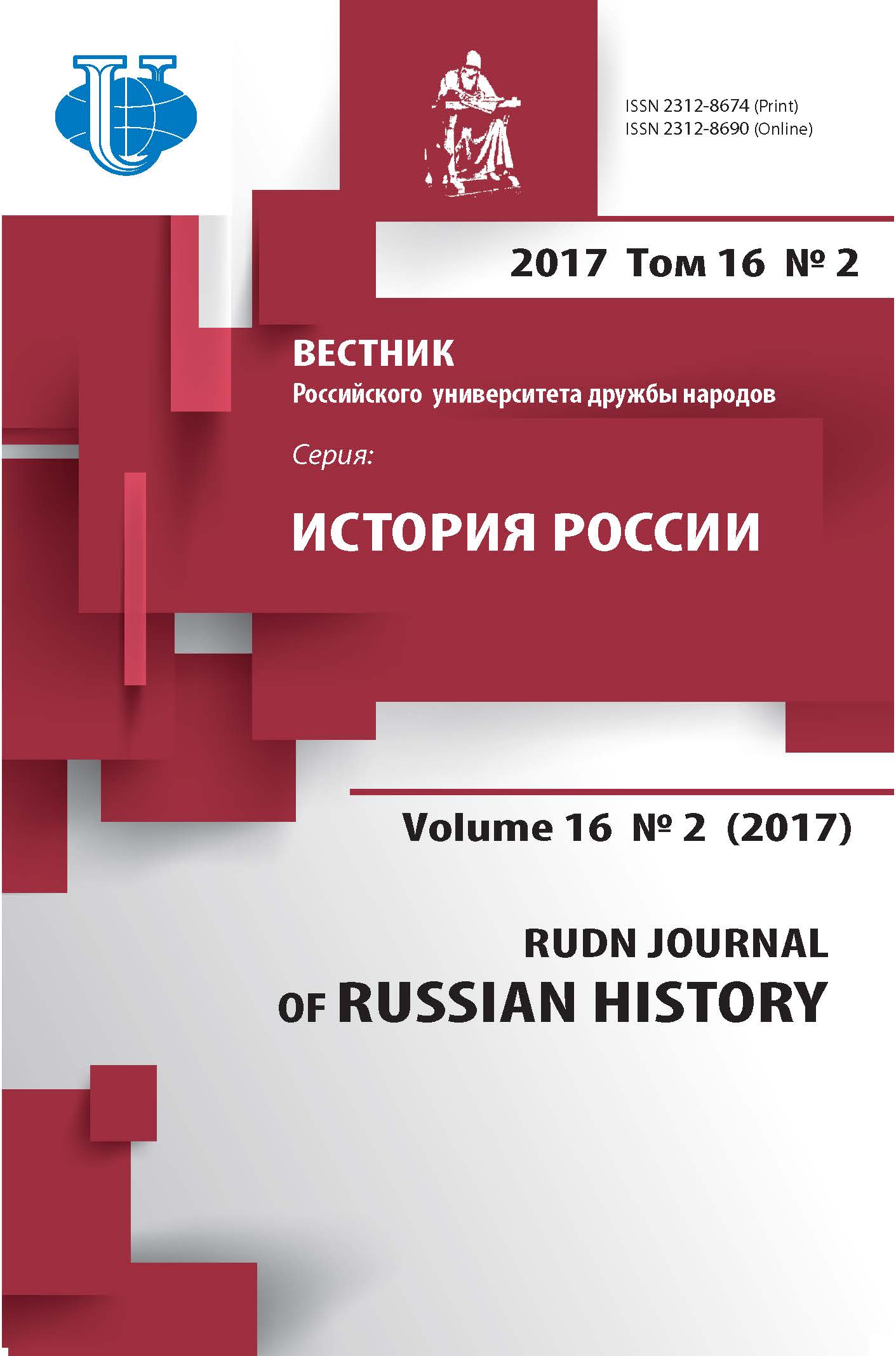FATES OF RUSSIAN ART IN THE YEARS OF REVOLUTION AND CIVIL WAR (PECULIARITIES OF A.A. RYBNIKOV’S CREATIVE WORK)
- Authors: Aksenova G.V1
-
Affiliations:
- Moscow Pedagogical State University
- Issue: Vol 16, No 2 (2017)
- Pages: 223-252
- Section: REVOLUTION AND ART
- URL: https://journals.rudn.ru/russian-history/article/view/16657
- DOI: https://doi.org/10.22363/2312-8674-2017-16-2-223-252
Cite item
Full text / tables, figures
Abstract
The article is devoted to the fate of the intellectuals who came over to the Soviet power and participated in the revolutionary process. The analysis is carried out on the example of the life and work of artist Alexei Rybnikov (1887-1949), who came from a merchant family, initially received economic education, graduated from Kharkov school of painting and drawin-gand participated in the exhibitions of “Jack of diamonds”.There are considered the peculiarities of his pre-revolutionary art. The author notes the role of the artist in the rescue of the unique art collections in the years of his work in the People’s Commissariat for Education. There is shownhow the Revolution and the Civil war, the nationalization and requisition of artistic values changed the processes of museum construction in Russia and then the Soviet Union. The author points out that the process of nationalization of the historical and artistic values revealed one of the important issues related to the conservation of works of art - the problem of restoration. The solution to this problem was associated with the need to study the technological characteristics of the paintings by old masters, to record the physical condition of all existing works of art, to describe its technical condition. There is shown that the practical work of rescue and restoration of the old masters’ heritage, which was carried out at the State Tretyakov gallery and the Hermitage by artists, technologists, photographers and scientists (chemists and physicists), led to the discovery of new methods of paintings salvation. Russian artist Alexei Rybnikov began his career before the revolution of 1917 as a painter, book designer and muralist.Like many other representatives of this profession, at first he became an officer of the People’s Commissariat for Education, then an employee of a museum. This path of a free artist’s transformation into a serious museum employee gave the world a new way of washing paintings, and then the method of texture photography invented by him. In the history of the world restoration this method is known as “Methode Rybnikoff’.
About the authors
Galina V Aksenova
Moscow Pedagogical State University
Author for correspondence.
Email: galax23@yandex.ru
Dr. in history, Professor of the Department of Russian history at Moscow Pedagogical State University
88, Vernadsky Pr., Moscow, 11557, RussiaReferences
- Kucherenko GS, Aksenova GV, Gavrilichev VA, Plavinskaja NYu., Sokolova MN, Jurchenkova LV, eds. Velikaja Francuzskaja burzhuaznaja revoljucija. Ukazatel’ russkoj i sovetskoj literatury [The great French bourgeois revolution. Index of Russian and Soviet literature]. Moscow: INION AN SSSR; 1987 (in Russian).
- Richard S. Wortman. Scenarios of power. Myths and Ceremonies of Russian Monarchy. Moscow; 2004: 1 (in Russian).
- Aksenova GV. Knigi Zh.F. Lagarpa v Rossii poslednej treti XVIII - nach. XIX vv. [Books by J. F. La Harpe in Russia last third of the XVIII - early XIX centuries]. Kniga v Rossii XVI- serediny XIXvekov. Sb. nauch. trudov. Leningrad: BAN; 1990: 169-176 (in Russian).
- Aksenova GV. Russian translations of the works of Fran?ois de La Harpe. Kniga: Issledo-vanija i materialy [Book: Reseurchers and materials]. Moscow: Knizhnaja palata, 1992; 64: 69-81 (in Russian).
- Galay YuG., Miheeva IV. Pravotvorchestvo Ministerstva vnutrennih del Rossijskoj imperii po ohrane pamjatnikov stariny [The lawmaking of the Ministry of internal Affairs of the Russian Empire for the protection of ancient monuments]. Nizhnii Novgorod: Nizhegorodskii juridicheskii institut MVD; 2001 (in Russian).
- Galaj YuG., Pronina EN. Gosudarstvenno-pravovaja ohranapravoslavnogo kul’turnogo nasledija v Rossii v XVIII-XX vekah [State legal protection of the Orthodox cultural heritage in Russia in XVIII-XX centuries]. Moscow: NOTA BENE; 2008 (in Russian).
- Miheeva IV. Pravotvorcheskaja dejatel’nost’Ministerstva vnutrennih del Rossijskoj imperii po ohranepamjatnikov istorii i kul’tury v XIX- nachaleXXvekov [Legislative activities of the Ministry of internal Affairs of the Russian Empire for the protection of monuments of history and culture in the XIX - early XX centuries]. N. Novgorod: Rastr-NN; 2009 (in Russian).
- Lunacharskii AV. Ob izobrazitel’nom iskusstve: Sbornik [Of the fine arts: Collection]. Moscow: Sovetskii hudozhnik; 1967 (in Russian).
- Lunacharskii AV Ob iskusstve [About art]. Moscow: Iskusstvo, 1982; 2 (in Russian).
- Vagner R. Iskusstvo i revoljuciya [Art and revolution]. Saint Petersburg: S.E. Grozmani; 1908 (in Russian).
- Vagner R. Iskusstvo i revolyuciya [Art and revolution]. Petrograd: Lit.-izd. otd. Narod-nogo komissariata po prosveshheniyu; 1918 (in Russian).
- Blok AA. Iskusstvo i Revolyuciya (Po povodu tvoreniya Riharda Vagnera) [Art and Revolution (on Richard Wagner’s works)]. Moscow: Sovremennik; 1979 (in Russian).
- Ohrana kul ’turnogo nasledija XVII - XX vv. Hrestomatiya [The protection of cultural heritage of XVII - XX centuries]. Moscow: Izdatel’stvo «Ves’ mir», 2000; 1 (in Russian).
- Rodchenko AM. Stat’i. Vospominanija. Avtobiograficheskie zapiski. Pis’ma [Article. Memories. Autobiographical notes. Letters]. Moscow: Sovetskii hudozhnik; 1982 (in Russian).
- Lavrent’ev AN. Aleksandr Rodchenko. Moscow: Arhitektura-S; 2007 (in Russian).
- Lavrent’ev A., ed. Mayakovsky-Rodchenko. The constructivist classics. Moscow: Fortuna JeL; 2004 (in Russian).
- Vashik K, Baburina N. Iskusstvo russkogo plakata. Real’nost’ utopii [The art of the Russian poster. The reality of utopia]. Moscow: Progress-Tradiciya; 2004 (in Russian).
- Timoshin GA. Mitrofan Borisovich Grekov. Zhizn’ i tvorchestvo [Mitrofan Borisovich Grekov. Life and work]. Moscow: Sovetskii hudozhnik; 1961 (in Russian).
- Aksenova GV. Predystorija studii voennyh hudozhnikov imeni M.B. Grekova: rasskaz o teh, kto voeval karandashom, kraskami i kist’ju [The background of the Studio of military artists named after M.B. Grekov: the story of those who fought in pencil, paint and brush].Vestnik Lipeckogo gosudarstvennogo pedagogicheskogo universiteta. Serija: gu-manitarnye nauki. 2015; 11(2): 19-28 (in Russian).
- Tkachenko VYa. Nikolay Semenovich Samokish. Zhizn ’ i tvorchestvo: 1860-1944 [Nikolai Semenovich Samokish. Life and work: 1860-1944]. Moscow; 1964 (in Russian).
- Shleev VV. Revoljuciya i izobrazitel’noe iskusstvo [Revolution and fine arts]. Moscow: Izobrazitel’noe iskusstvo; 1987 (in Russian).
- Filagina VV. Velikaya Oktjabr’skaya socialisticheskaya revoljuciya: bibliograficheskii ukazatel’dokumental’nyhpublikacii [The great October socialist revolution: a bibliography of documentary publications]. Moscow: b.i.; 1957 (in Russian).
- Gorodeckii EN, ed. Velikaya Oktjabr ’skaya Socialisticheskaya Revolyuciya. bibliograficheskii ukazatel’ dokumental’nyh publikacij [Socialist Revolution. A bibliography of documentary publications]. Moscow: Izdatel’stvo Vsesojuznoj knizhnoj palaty; 1961 (in Russian).
- Bushuev SV. Istoriya gosudarstva Rossiyskogo: Ist.-bibliogr ocherki. Moscow: Kn. Pa-lata; 1994 (in Russian).
- Nasedkin K, ed. Vse muzei Rossii. Jenciklopedicheskij spravochnik. Moscow: Bestseller; 2005-2006 (in Russian).
- Raev MI. Rossiya za rubezhom. Istoriya kul’tury russkoy jemigracii 1919-1939 [Russia abroad. History of culture of the Russian emigration 1919-1939]. Moscow: Progress-Akademija; 1994 (in Russian).
- Chelyshev EP,Shahovskoy DM. Kul’turnoe nasledie rossijskoj jemigracii: 1917-1940. Vdvuh knigah [Cultural heritage of Russian emigration: 1917-1940]. Moscow: Nasledie; 1994 (in Russian).
- Vzdornov GI., Zaleskaja ZE., Lelekova OV. Obshhestvo «Ikona» v Parizhe [The society “Icon” in Paris]. Moscow: Progress-Tradicija; 2002 (in Russian).
- Ershov VF. Rossiyskaja hudozhestvennaya jemigraciya vo Francii v 1920-1930-e gg. [The art of the Russian emigration in France in the 1920-1930-ies]. Moscow: MAKS Press; 2008 (in Russian).
- Leykind OL., Mahrov KV, Severyukhin DYa. Hudozhniki Russkogo Zarubezh’ja, 1917-1939: Biograficheskij slovar’ [Artists of the Russian Diaspora, 1917-1939: Biographical dictionary]. St-Petersburg: Notabene; 1999 (in Russian).
- Chumakov VN, ed. Nezabytye mogily: rossijskoe zarubezh’e: nekrologi 1917-1997 [Unforgotten graves: Russian abroad: obituaries 1917-1997]. Moscow: Pashkov dom; 1999-2007 (in Russian).
- Galay YuG. Vlast’i istoriko-kul’turnye cennosti v Rossijskoj Federacii, 1917-1929 gg.: Istoriko-pravovoj aspekt [Power and historico-cultural values in the Russian Federation, 1917-1929 gg: Istoriko-legal aspect]. Nizhny Novgorod: Nizhegor. jurid. in-t MVD; 1997 (in Russian).
- Galay Yu.G. Hranit’ istorii sledy Ohrana pamjatnikov istorii i kul’tury na Nizhegorod-skoj zemle, 1917-1941 gg. [Store history tracks. Protection of monuments of history and culture of the Nizhny Novgorod region, 1917-1941]. Gor’kiy: Volgo-Vyatskoe knizhnoe izdatel’stvo; 1989 (in Russian).
- Rybnikov AA. Faktura klassicheskoj kartiny [The texture of classical paintings]. Moscow: Gosudarstvennaja Tret’jakovskaja Galereja; 1927 (in Russian).
- Rybnikov AA. Tehnika masljanoj zhivopisi [The technique of oil painting]. Moscow: VSEKOHUDOZhNIK; 1929 (in Russian).
- Chennino Chennini. Kniga ob iskusstve ili Traktat o zhivopisi [The book of art or Treatise on painting]. Moscow: OGIZ-IZOGIZ; 1933 (in Russian).
- Berger E. Istoriya razvitiya tehniki maslyanoi zhivopisi [The history of the development of the art of oil painting]. Moscow: IZOGIZ, 1935 (in Russian).
- Rybnikova-Bubnova PA. Glavy semejnogo romana [The head family of the novel]. Moscow: N’yudiamed Publ.; 1994 (in Russian).
- Rybnikova-Bubnova PA. Glavy semejnogo romana [The head family of the novel]. Moscow: N’yudiamed Publ.; 2003 (in Russian).
- Konchin EV Sohranennye sokrovishha [Stored treasures]. Moscow: Prosveshhenie; 1985 (in Russian).
- Lisenkova EA, Shashkina MV, eds. Aleksey Aleksandrovich Rybnikov, 1887-1949: Zhi-vopis’: Katalog vystavki [Alexey Rybnikov, 1887-1949: Paintings: exhibition Catalogue]. Moscow: Sovetskii hudozhnik; 1988 (in Russian).
- Polovcev AA. Russkii biograficheskii slovar’ [Russian biographical dictionary]. Petrograd, 1918; 17 (in Russian).
- Vladislav Jarovickii. 100 velikih psihologov [100 great psychologists]. Moscow: Veche; 2003 (in Russian).
- Москва. Moscou. Moskau. Moscow: Tovarishhestvo Skoropechatni A.A. Levenson; 1912 (in Russian, in French, in German).
- Pavlov IN. Zhizn’russkogo gravera [The life of the Russian engraver]. Moscow; Leningrad: Iskusstvo; 1940 (in Russian).
- Konchin EV. Jemissary vosemnadcatogo goda [The emissaries of eighteen]. Moscow: Moskovskii rabochii; 1981 (in Russian).
- Konchin EV. Revolyuciey prizvannye [Designed byrevolution]. Moscow: Moskovskii rabochii; 1988 (in Russian).
- Slavinskiy YuM. Sovetskaya Arktika: v proizvedenijah hudozhnikov V.P. Beljaeva, M.M. Beringova, A.A. Merkulova, A.A. Rybnikova i S.A. Storozhenko [Soviet Arctic: in creations of V.P. Belyaev, M.M. Beringov, A.A. Merkulov, A.A. Rybnikov and S.A. Storozhenko]. Moscow: VSEKOHUDOZhNIK; 1934 (in Russian).
- Lavrov BV. Pervaya Lenskaya: Ocherki o pervom karavane sovetskih sudov, proshedshih cherez Severnyj ledovityj okean k ust’ju reki Leny [First Lena: Essays on the first convoy of Soviet ships passed through the Arctic ocean to the mouth of the Lena river]. Moscow: Molodaya gvardiya; 1936 (in Russian).
















